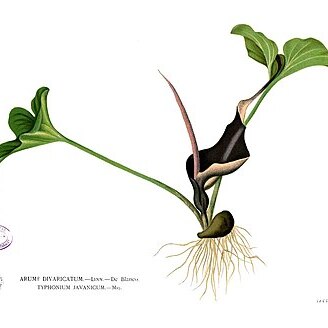Underground part a short, tuberous rhizome, subglobose or globose. Petiole 10-35 cm; leaf blade yellowish green abaxially, dark green adaxially, reniform-hastate, triangular in outline, shallowly or deeply 3-lobed; terminal lobe ovate, (5-)9-17 × 4-14 cm, acuminate; lateral lobes spreading, obliquely ovate or narrowly ovate. Inflorescence appearing after leaves; peduncle creamy red with dark purple dots, 2-9 cm. Spathe outside whitish or pale green with purple striae, inside purple, base ovoid, 2-3.5 × ca. 1.5 cm; limb outside purplish mixed with dirty green flush or striae, or purple all over, inside deep rich purple, ovate-lanceolate, abruptly tapering from below middle, usually twisted at tip, 13-15 × ca. 5 cm. Spadix subequaling spathe; female zone 4-5.5 mm; ovary white or yellowish, ovoid; stigma purple, 1-loculed, 1-ovuled; sterile zone 1.5-2.2 cm, proximal 5-7 mm densely covered with staminodes, rest naked; staminodes downcurved, yellow or pale yellow, subcylindric, 8-9 mm, acute; male zone 7-12 mm; male flowers consisting of 2 or 3 stamens, yellow; anthers sessile, opening with apical pore; appendix dark purple, narrowly conic, 12-15 cm, 3-4 mm in diam. at base, base truncate with a pale red stipe ca. 2 mm. Berries pale green at first, white when mature, ovoid or ellipsoid, 1-seeded. Fl. and fr. May-Aug.
More
Acaulescent herb with subglobose tuber.. Leaves radical; blade shallowly to deeply hastate-trilobed, 10–13 cm. long, 12–16 cm. broad; petiole 15–17(–30) cm. long.. Peduncle short.. Spathe 19(–30) cm. long; tube 3 cm. long, blade 16(–27) cm. long, long-acuminate, dark reddish purple.. Spadix slightly shorter than spathe; sterile appendix 8-15 cm. long, slender, dark red; sterile filaments above pistils acicular, downturned, yellowish to reddish.. Flowers unisexual, lacking tepals.
A herb. It grows 10-45 cm tall. The corm is a flattened round shape. It is 3.5 cm across. It forms roots at the top. The leaves usually have 3 shallow lobes. They are usually more broad than long. The leaf stalk is 30 cm long. The flower stalk is 10 cm long. The fruit is a 1-2 seeded berry.

